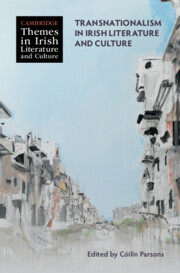Book contents
- Transnationalism in Irish Literature and Culture
- Cambridge Themes in Irish Literature and Culture
- Transnationalism in Irish Literature and Culture
- Copyright page
- Contents
- Acknowledgments
- Contributors
- Introduction: A Weak Theory of Transnationalism
- Part I Transnational Genealogies
- Chapter 1 “A World of New Wonders”: Maria Edgeworth’s Atlantic Ecology and the Limits of Transnationalism in the Nineteenth Century
- Chapter 2 “I’m apparently not famous anymore”: Appropriating Dion Boucicault’s Octoroon and Reckoning with Racial Violence in America
- Chapter 3 Destitute Recollection: Joyce’s Indian Translocations
- Chapter 4 “Under the shadow of the Monument”: On First Looking into Finnegans Wake
- Chapter 5 Eironesian Island Others: Irish Islands within Pacific Waters
- Part II Planets
- Part III Missed Translations
- Part IV Transnational Futures
- Select Bibliography
- Index
Chapter 5 - Eironesian Island Others: Irish Islands within Pacific Waters
from Part I - Transnational Genealogies
Published online by Cambridge University Press: 13 November 2024
- Transnationalism in Irish Literature and Culture
- Cambridge Themes in Irish Literature and Culture
- Transnationalism in Irish Literature and Culture
- Copyright page
- Contents
- Acknowledgments
- Contributors
- Introduction: A Weak Theory of Transnationalism
- Part I Transnational Genealogies
- Chapter 1 “A World of New Wonders”: Maria Edgeworth’s Atlantic Ecology and the Limits of Transnationalism in the Nineteenth Century
- Chapter 2 “I’m apparently not famous anymore”: Appropriating Dion Boucicault’s Octoroon and Reckoning with Racial Violence in America
- Chapter 3 Destitute Recollection: Joyce’s Indian Translocations
- Chapter 4 “Under the shadow of the Monument”: On First Looking into Finnegans Wake
- Chapter 5 Eironesian Island Others: Irish Islands within Pacific Waters
- Part II Planets
- Part III Missed Translations
- Part IV Transnational Futures
- Select Bibliography
- Index
Summary
This chapter traces the ways familiar depictions of Ireland are interrupted when we consider some of the rare co-imaginings of Irish and Pacific islands. When watched alone, Robert Flaherty’s Man of Aran (1934) presents the non-modern in modern Ireland. But when watched alongside Moana (1926, Robert and Frances Flaherty), Man of Aran reveals the traveling nature of non-modern tropes, as the Pacific non-modern and the Irish non-modern coalesce. The transoceanic movement of the “novel savage” is emphasized, and the quintessentially Irish becomes recognizably interislander. By tracing the connections between Ireland and the Cook Islands in Kenneth Sheils Reddin’s Another Shore (1945), as well as Charles Crichton’s 1948 adaptation, we see that Reddin draws on the seeming incontrovertibility of the Pacific’s arcadia to establish, first, Dublin’s modernity, then Dublin’s non-modernity, then the erroneous, nebulous nature of such categories. By tracing the transnational movement of tropes and stereotypes across Ireland and the Pacific, area studies divisions collapse and we recognize Ireland as part of a global archipelago of islands of discounted, nascent, imbricated modernity.
Keywords
- Type
- Chapter
- Information
- Transnationalism in Irish Literature and Culture , pp. 99 - 116Publisher: Cambridge University PressPrint publication year: 2024

